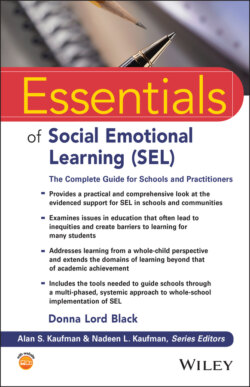Читать книгу Essentials of Social Emotional Learning (SEL) - Donna Lord Black - Страница 29
Rapid Reference 1.3 Seven Suggestions for Avoiding the Pitfalls of SEL and Delivering on Its Promise
Оглавление1 Slow down and focus on getting it right. While the need for SEL may be high, going fast may not be the best approach. Growing the program steadily and slowly will make it possible to focus on doing it wisely and well. A calibrated rollout can increase the likelihood of positive change.
2 Be clear about what SEL is and is not. It can be tempting and much easier to build momentum and win allies by offering an inclusive or generic definition of SEL, but proponents need to make clear that SEL is not a replacement for rigorous instruction. Instead, it enhances instruction. It rests on legitimate research, and it is part of preparing students to become competent adults and responsible citizens.
3 Make sure that character and civic education loom large in the SEL portfolio. The link between SEL, civic education, and character education is equally as important as the link between SEL and academic achievement. Promoting character formation and preparation for responsible citizenship should be critical elements of the SEL portfolio.
4 Making schools safer is an appealing facet of SEL, so long as the transcendent point is student safety, not adult agendas. The goal of SEL should not be about promoting political and legal debates over discipline policy and practices, but should adhere to the goal of making students feel safe and valued. Strategies for doing this should be held to the standards of evidence, not to standards that are ideologically friendly or politically useful.
5 Parental enthusiasm for SEL is healthy, but it ought not to become a free pass for academic frailty. Social emotional learning is inextricably linked to academic learning, and it is important to help parents understand this. Policy makers can help by making vivid connections between SEL and academic achievement on report cards and through accountability systems.
6 Make it a priority to develop valid, reliable, intuitive metrics for SEL—and be honest about their limits. More reliable instruments are needed for measuring SEL. This will improve credibility while also allowing schools to view SEL outcomes alongside academic data. School climate surveys are a start, but they are subjective and thus not sufficient. A relentless commitment to evidence will increase credibility, but when evidence is shaky, it should be acknowledged and not downplayed. Emphasis on transparency and integrity is critical and includes distinguishing between “solid evidence” and “thoughtful opinion.”
7 In celebrating “evidence‐based” practices and encouraging further research, be wary of analysts who give short shrift to how their findings translate to the real world. Evidence‐based recommendations often play out better in controlled environments than they do in the real world. SEL does not yet have large sets of data on implementation, and while this is needed, careful evaluation of efficacy will be critical. SEL researchers and advocates should seek feedback and evidence on what can go wrong in the real world when considering which interventions can make a difference and under what conditions.
Source: Finn, C.E., & Hess, F.M. (2019). What social and emotional learning needs to succeed and survive. Washington, DC: American Enterprise Institute. Reprinted with permission of Finn, C.E., Jr., Hess, F. and EducationNext.
